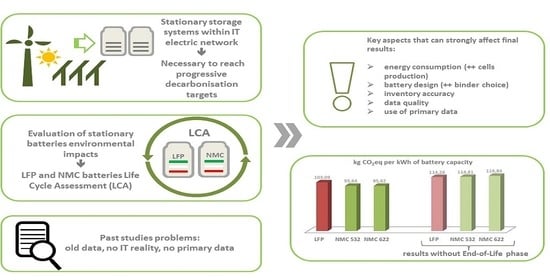Life Cycle Assessment of Stationary Storage Systems within the Italian Electric Network
Abstract
1. Introduction
2. Materials and Methods
2.1. Goal and Scope
2.2. Functional Unit
2.3. System Definition
2.4. Battery Components and Technology
Cells Composition and Main Features
2.5. System Boundaries
2.6. Allocation System
2.7. Impact Categories and Methods
2.8. Life Cycle Inventory (LCI)
2.8.1. Battery Construction
2.8.2. Use Phase
2.8.3. End-of-Life
3. Results and Discussion: Life Cycle Impact Assessment (LCIA)
3.1. Cell Production and Assembly
- Additionally, for the negative electrode, the following important differences were observed.
3.2. Battery Production and End-of-Life
Comparison with the Literature
3.3. Including Use Phase
3.4. Sensivity and Uncertainty Analysis
- IT: Italian medium-voltage mix at 2018 [32] (1 kWh mix medium-voltage IT has 4.55 × 10−1 kg CO2 eq).
- EU: European average medium-voltage mix ENTSO-E (European Network of Transmission Systems Operators for Electricity) from the Ecoinvent database (1 kWh mix medium-voltage EU has 4.76 × 10−1 kg CO2 eq) [30].
- CN: Chinese medium-voltage mix from the Ecoinvent database (1 kWh mix medium-voltage CN has 1.14 kg CO2 eq) [30].
4. Conclusions
Supplementary Materials
Author Contributions
Funding
Institutional Review Board Statement
Informed Consent Statement
Data Availability Statement
Acknowledgments
Conflicts of Interest
References
- Economico, M.D.S.; Della Tutela, M.D.A.E.; del Territorio, E.M.D.I.; Dei Trasporti, E. Piano Nazionale Integrato per l’Energia e il Clima; Ministero dello Sviluppo Economico: Rome, Italy, 2019.
- ISO—The International Organization for Standardization. ISO 14040:2006: Environmental Management—Life Cycle Assessment—Principles and Framework; ISO: Geneva, Switzerland, 2006. [Google Scholar]
- Ellingsen, L.A.W.; Majeau-Bettez, G.; Singh, B.; Srivastava, A.K.; Valøen, L.O.; Strømman, A.H. Life Cycle Assessment of a Lithium-Ion Battery Vehicle Pack. J. Ind. Ecol. 2014, 18, 113–124. [Google Scholar] [CrossRef]
- Hiremath, M.; Siebenhuener, B.; Vogt, T.; Heinemann, D. Comparative Life Cycle Assessment of Stationary Battery Storage Technologies for Balancing Fluctuations of Renewable Energy Sources. Master’s Thesis, University of Oldenburg, Oldenburg, Germany, 2014. [Google Scholar]
- Hiremath, M.; Derendorf, K.; Vogt, T. Comparative Life Cycle Assessment of Battery Storage Sistems for Stationary Applications. Environ. Sci. Technol. 2015, 19, 4825–4833. [Google Scholar] [CrossRef] [PubMed]
- Longo, S.; Antonucci, V.; Cellura, M.; Ferraro, M. Life cycle assessment of storage systems: The case study of a sodium/nickel chloride battery. J. Clean. Prod. 2014, 85, 337–346. [Google Scholar] [CrossRef]
- Temporelli, A.; Mela, G. Analisi di Letteratura e Aspetti Metodologici per la LCA ed LCC delle Batterie Stazionarie; RSE SpA: Milano, Italy, 2019. [Google Scholar]
- Denholm, P.; Kulcinski, G.L. Life cycle energy requirements and greenhouse gas emissions from large scale energy storage systems. Energy Convers. Manag. 2004, 45, 2153–2172. [Google Scholar] [CrossRef]
- Rydh, C.J. Environmental assessment of vanadium redox and lead-acid batteries for stationary energy storage. J. Power Sour. 1999, 80, 21–29. [Google Scholar] [CrossRef]
- Wang, Q.; Liu, W.; Yuan, X.; Tang, H.; Tang, Y.; Wang, M.; Zuo, J.; Song, Z.; Sun, J. Life cycle assessment of lithium-ion batteries for greenhouse gas emissions. Resour. Conserv. Recycl. 2017, 117, 285–293. [Google Scholar]
- Wang, Q.; Liu, W.; Yuan, X.; Tang, H.; Tang, Y.; Wang, M.; Zuo, J.; Song, Z.; Sun, J. Environmental impact analysis and process optimization of batteries based on life cycle assessment. J. Clean. Prod. 2018, 174, 1262–1273. [Google Scholar] [CrossRef]
- Mahmud, M.A.; Huda, N.; Farjana, S.H.; Lang, C. Comparative life cycle environmental impact analysis of lithium-ion (LiIo) and nickel-metal hydride (NiMH) batteries. Batteries 2019, 5, 22. [Google Scholar] [CrossRef]
- Sullivan, J.L.; Gaines, L. Status of life cycle inventories for batteries. Energy Convers. Manag. 2012, 58, 134–148. [Google Scholar] [CrossRef]
- Sullivan, J.L.; Gaines, L. A Review of Battery Life-Cycle Analysis: State of Knowledge and Critical Needs; U.S. Department of Energy: Chicago, IL, USA, 2010.
- Spanos, C.; Turney, D.E.; Fthenakis, V. Life-cycle analysis of flow-assisted nickel zinc-, manganese dioxide-, and valve-regulated lead acid batteries designed for demand-charge reduction. Renew. Sustain. Energy Rev. 2015, 43, 478–494. [Google Scholar] [CrossRef]
- Vandepaer, L.; Colutiere, J.; Amor, B. Environmental impacts of Lithium Metal Polymer and Lithium-ion stationary batteries. Renew. Sustain. Energy Rev. 2017, 78, 46–60. [Google Scholar] [CrossRef]
- Temporelli, A.; Carvalho, M.L.; Girardi, P. Life Cycle Assessment of Electric Vehicle Batteries: An Overview of Recent Literature. Energies 2020, 13, 2864. [Google Scholar] [CrossRef]
- Salgado Delgado, M.A.; Usai, L.; Ellingsen, L.A.W.; Pan, Q.; Hammer Strømman, A. Comparative Life Cycle Assessment of a Novel Al-Ion and a Li-Ion Battery for Stationary Applications. Materials 2019, 12, 3270. [Google Scholar] [CrossRef]
- Chowdhury, J.I.; Balta-Ozkan, N.; Goglio, P.; Hu, Y.; Varga, L.; McCabe, L. Techno-environmental analysis of battery storage for grid level energy services. Renew. Sustain. Energy Rev. 2020, 131, 110018. [Google Scholar] [CrossRef]
- Pellow, M.A.; Ambrose, H.; Mulvaney, D.; Betita, R.; Shaw, S. Research gaps in environmental life cycle assessments of lithium ion batteries for grid-scale stationary energy storage systems: End-of-life options and other issues. Sustain. Mater. Technol. 2020, 23, e00120. [Google Scholar] [CrossRef]
- Majeau-Bettez, G.; Hawkins, T.R.; Strømman, A.H. Life Cycle Environmental Assessment of Lithium-Ion and Nickel Metal Hydride Batteries for Plug-In Hybrid and Battery Electric Vehicles. Environ. Sci. Technol. 2011, 45, 4548–4554. [Google Scholar] [CrossRef]
- ISO—The International Organization for Standardization. ISO 14044:2006: Environmental Management—Life Cycle Assessment—Requirements and Guidelines; ISO: Geneva, Switzerland, 2006. [Google Scholar]
- Cheng, K.W.E.; Divakar, B.P.; Wu, H.; Ding, K.; Ho, H.F. Battery-management system (BMS) and SoC development for electrical vehicles. IEEE Trans. Veh. Technol. 2011, 60, 76–88. [Google Scholar] [CrossRef]
- How, N.D.; Hannan, A.M.; Lipu, H.M.; Ker, J.P. State of Charge Estimation for Lithium-Ion Batteries Using Model-Based and Data-Driven Methods: A Review. IEEE Access. 2019, 7, 136116–136136. [Google Scholar] [CrossRef]
- Melentjev, S.; Lebedev, D. Overview of Simplified Mathematical Models of Batteries; Doctoral School of Energy and Geotechnology: Parnu, Estoni, 2013; pp. 231–235. [Google Scholar]
- Tremblay, O.; Dessaint, L.A. Experimental Validation of a Battery Dynamic Model for EV Applications. World Electr. Veh. J. 2009, 3, 2032–6653. [Google Scholar] [CrossRef]
- Sun, K.; Shu, Q. Overview of the types of battery models. In Proceedings of the 30th Chinese Control Conference, Yantai, China, 22–24 July 2011. [Google Scholar]
- Steubing, B.; Wernet, G.; Reinhard, J.; Bauer, C.; Moreno-Ruiz, E. The ecoinvent database version 3 (part II): Analyzing LCA results and comparison to version 2. Int. J. Life. Cycle Assess. 2016, 21, 1269–1281. [Google Scholar] [CrossRef]
- European Commission—Joint Research Centre—Institute for Environment and Sustainability, International Reference Life Cycle Data System (ILCD). Handbook—General Guide for Life Cycle Assessment—Detailed Guidance; EUR 24708 EN; Publications Office of the European Union: Luxemburg, 2010. [Google Scholar]
- Wernet, G.; Bauer, C.; Steubing, B.; Reinhard, J.; Moreno-Ruiz, E.; Weidema, B. The Ecoinvent database version 3 (Part I): Overview and methodology. Int. J. Life Cycle Assess. 2016, 21, 1218–1230. [Google Scholar] [CrossRef]
- Mohr, M.; Peters, J.F.; Baumann, M.; Weil, M. Toward a cell-chemistry specific life cycle assessment of lithium-ion battery recycling processes. J. Ind. Ecol. 2020, 24, 1310–1322. [Google Scholar] [CrossRef]
- Gargiulo, A.; Carvalho, M.L.; Girardi, P. Life Cycle Assessment of Italian Electricity Scenarios to 2030. Energies 2020, 13, 3852. [Google Scholar] [CrossRef]
- Lanati, F.; Gaeta, M.; Gelmini, A.; Gatti, A.; Mazzocchi, L. Studi a Supporto della Governance del Sistema Elettrico ed Energetico Nazionale; RSE SpA: Milano, Italy, 2019. [Google Scholar]
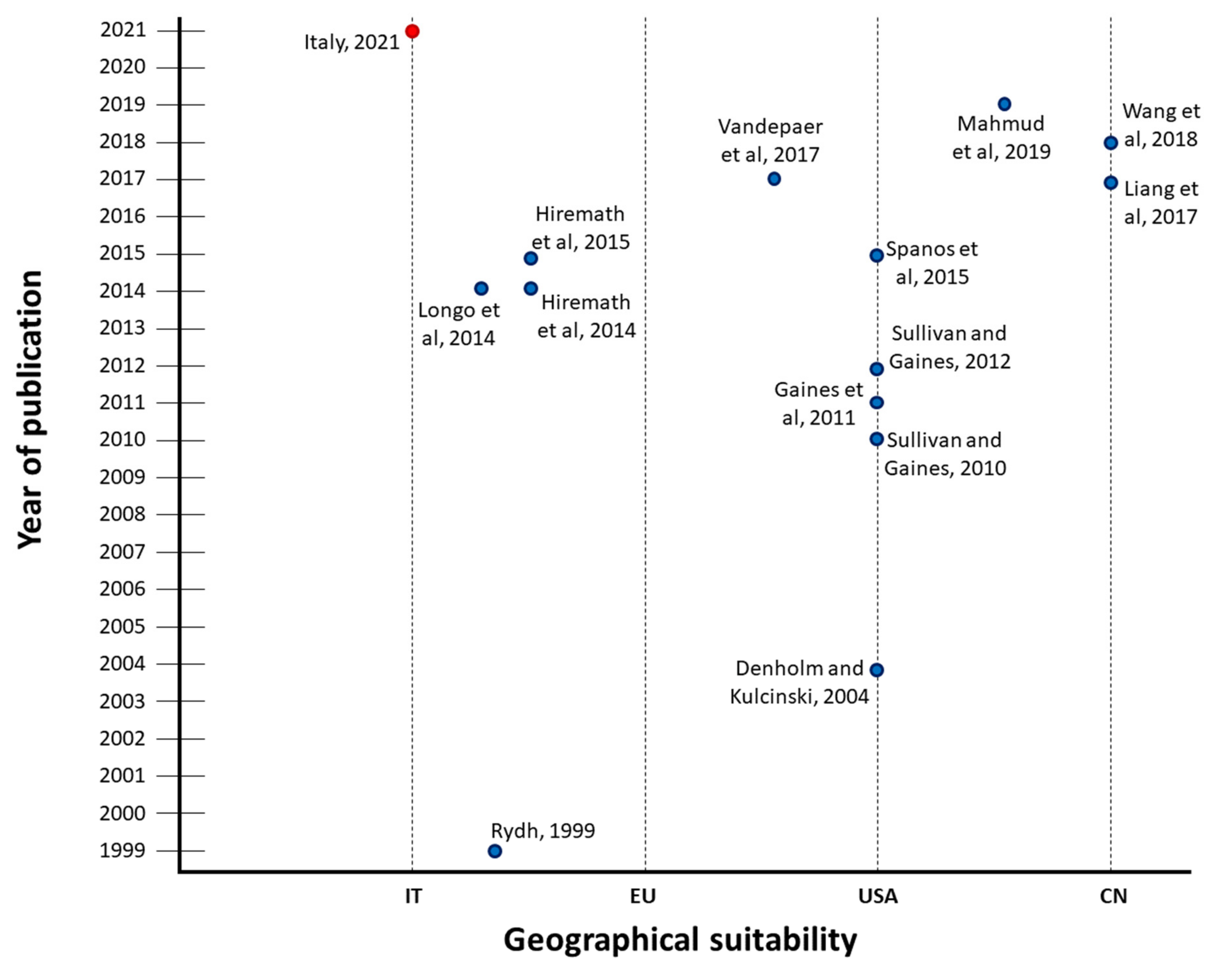
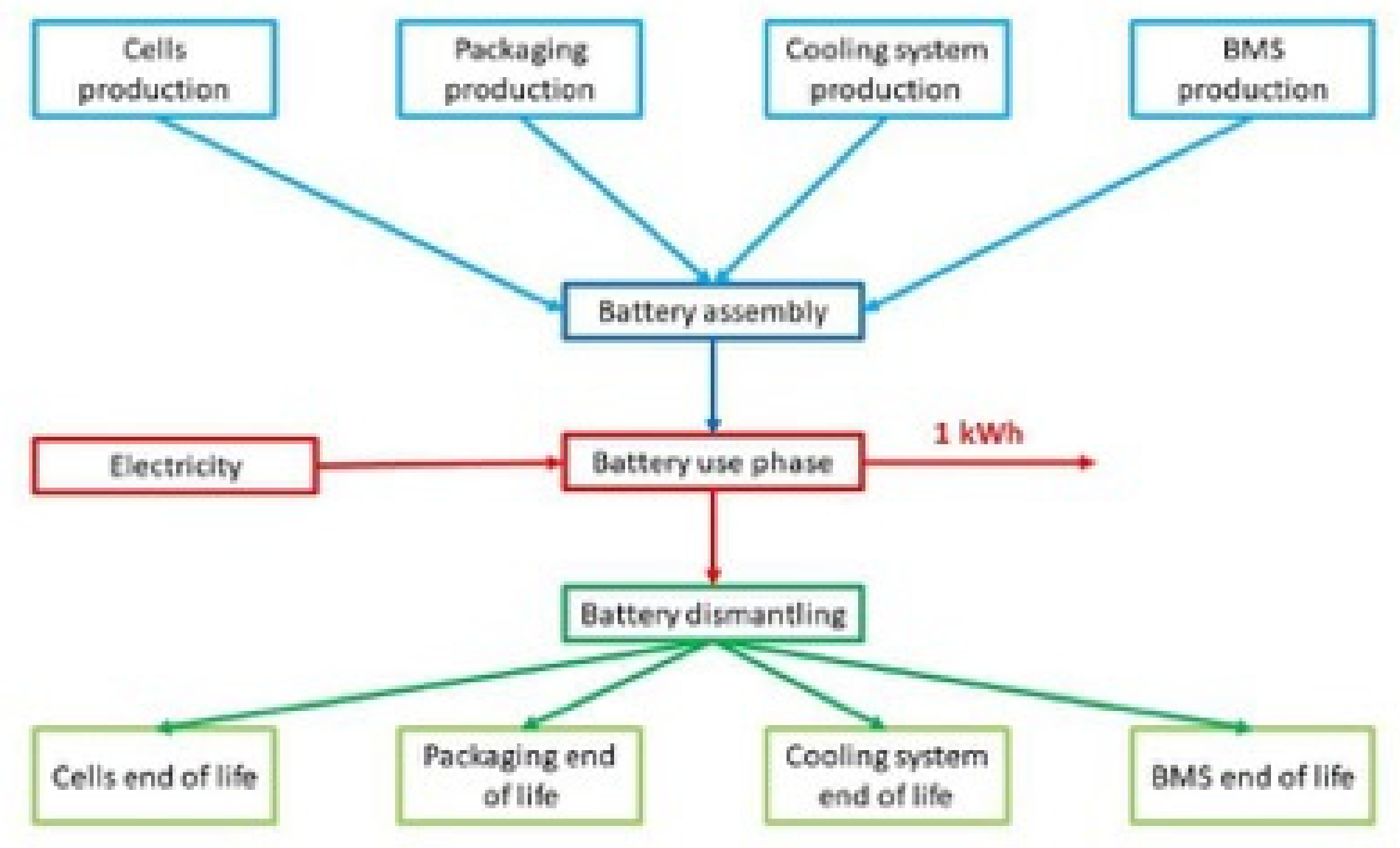
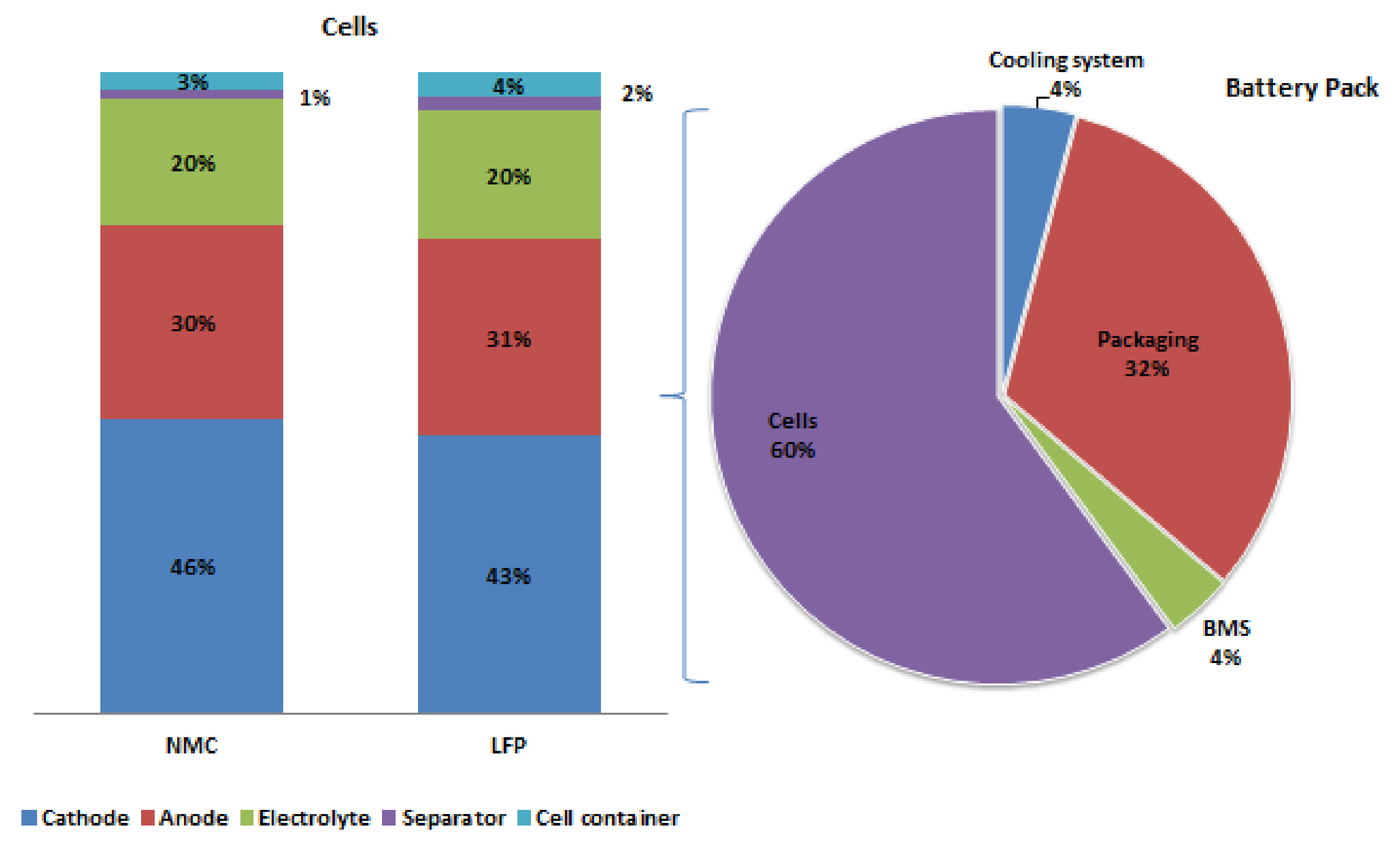
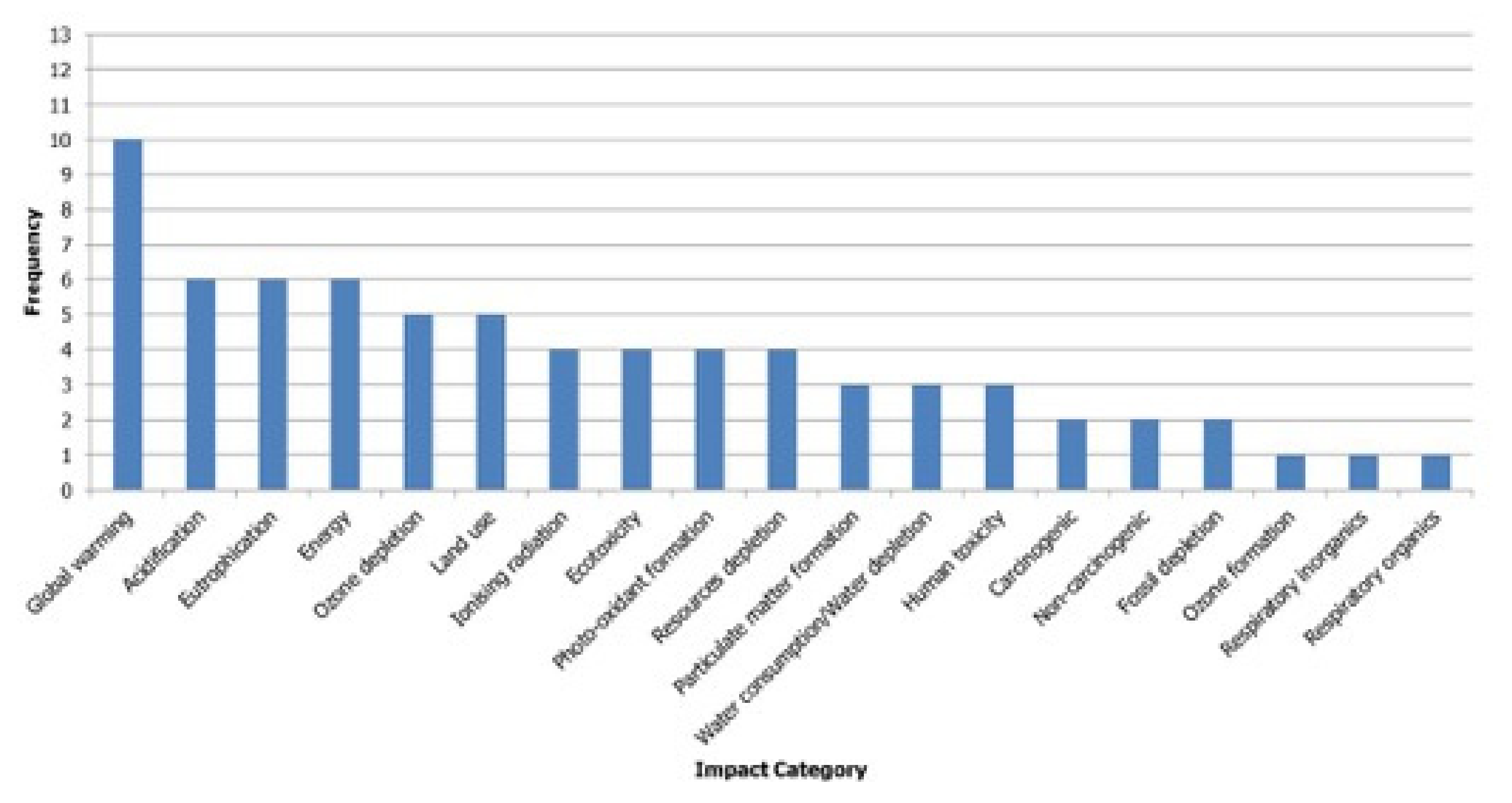
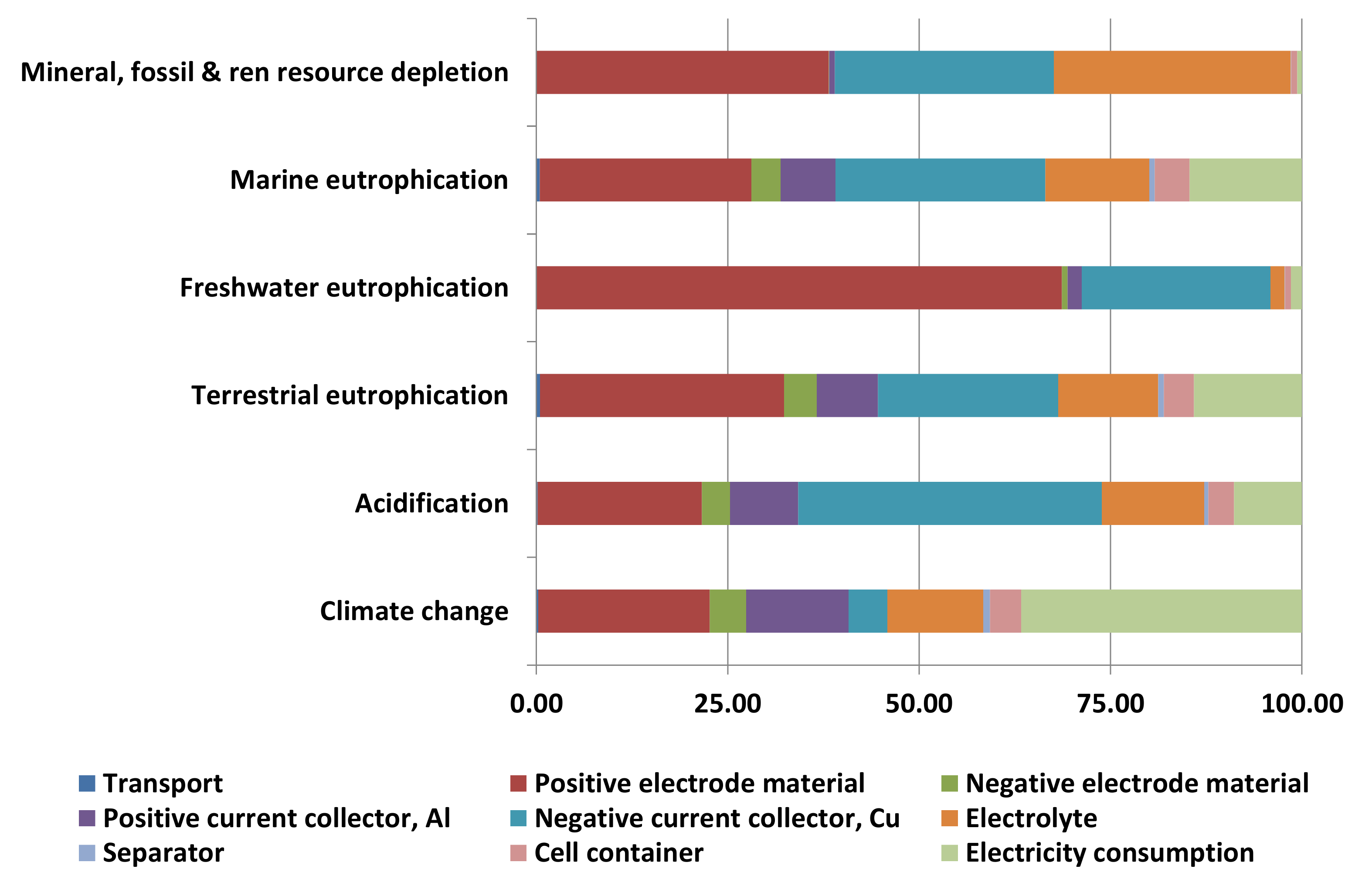
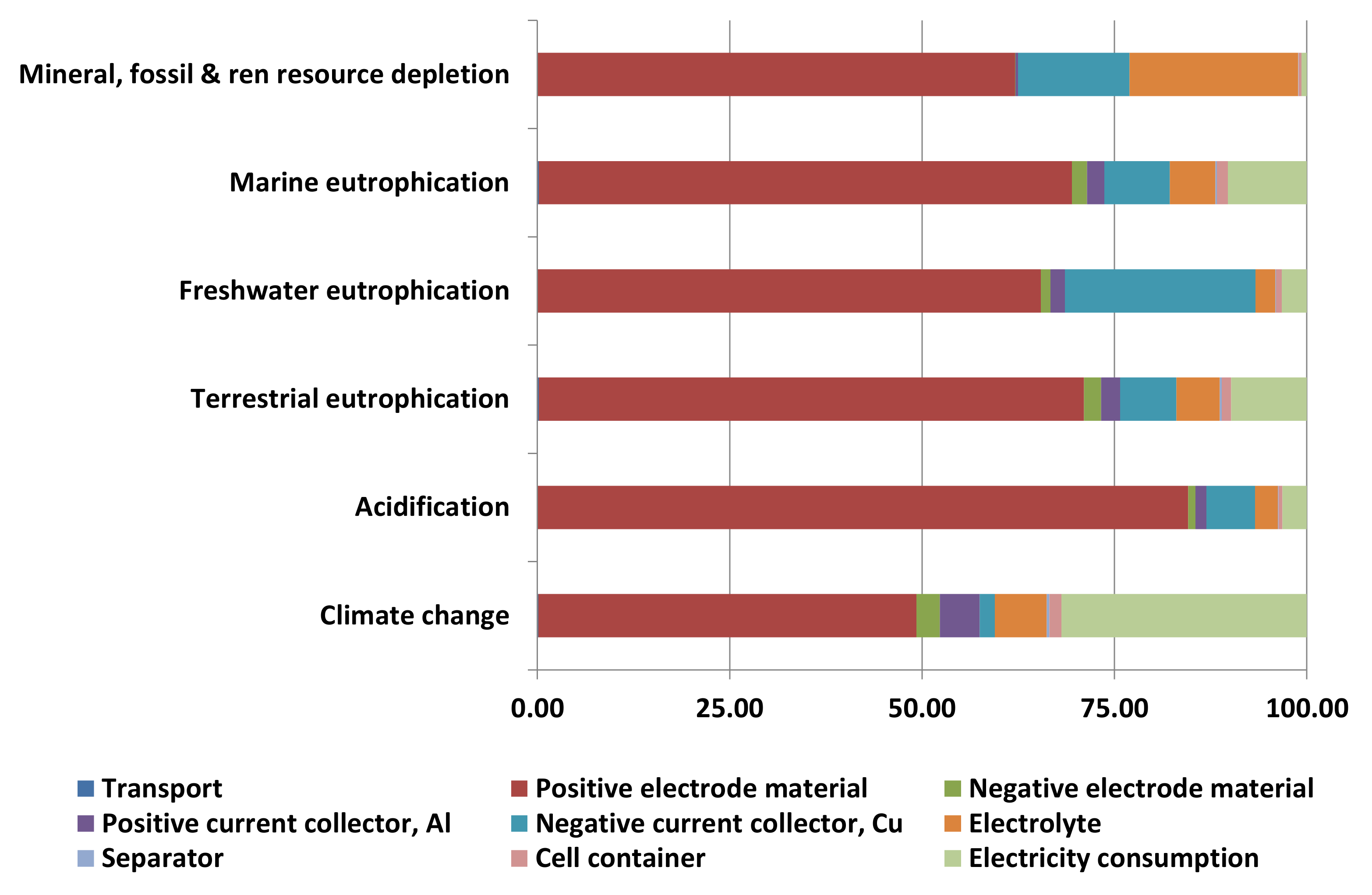
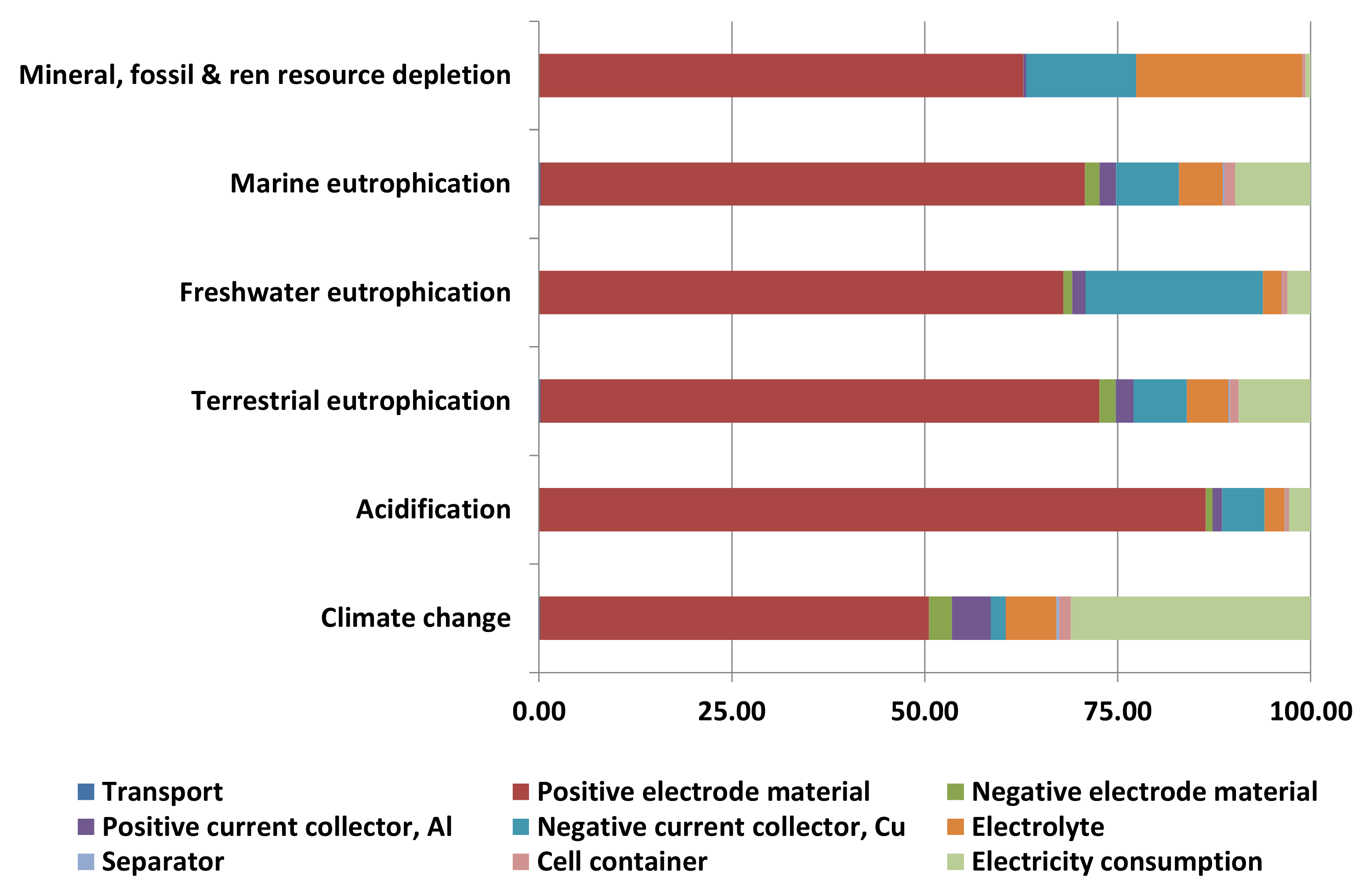
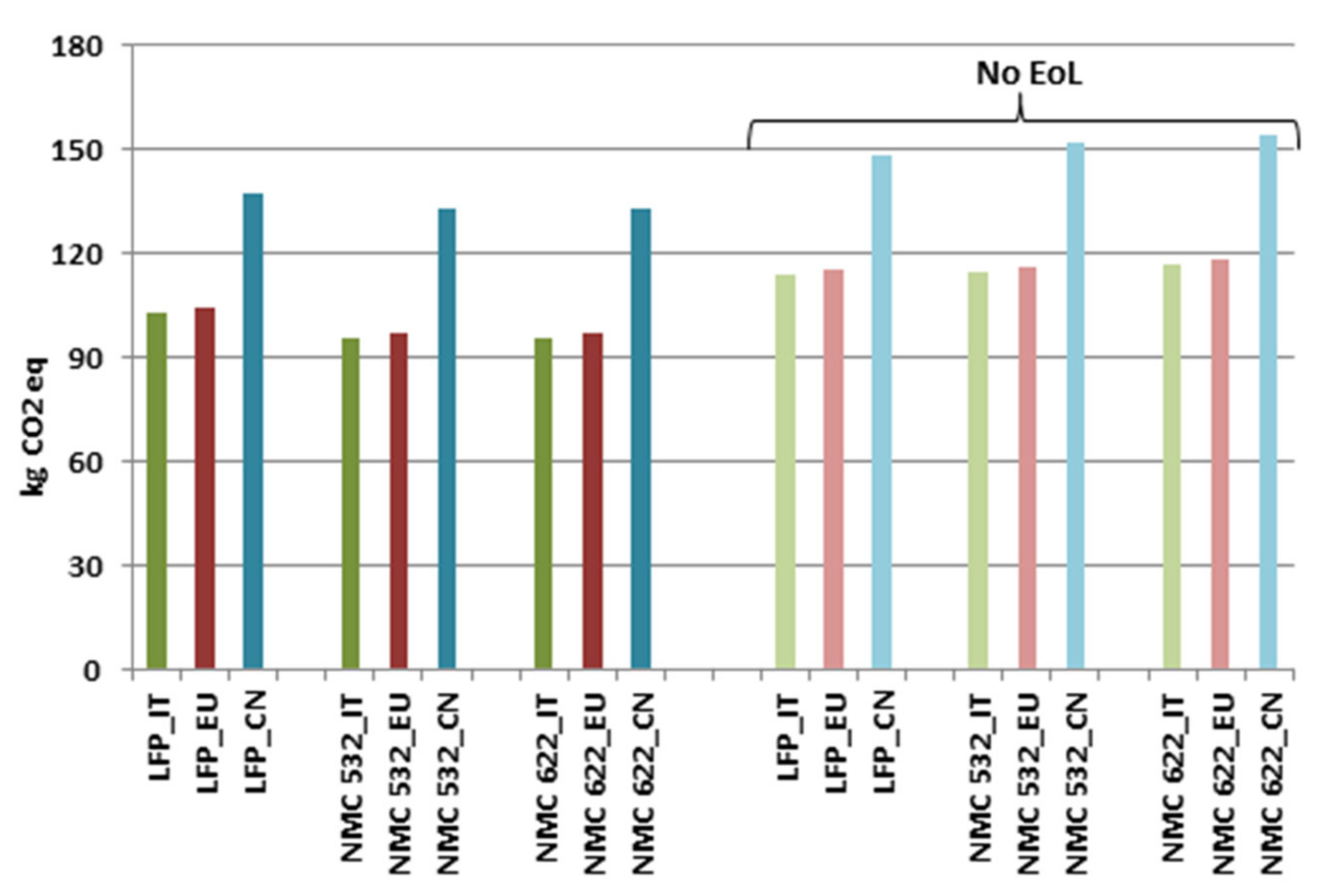
| Cell Technology | Cathode | Anode | Cell Voltage | Nominal Cell Capacity | Total Battery Pack Energy Density |
|---|---|---|---|---|---|
| (V) | (Ah) | (kWh kg−1) | |||
| LFP | LiFePO4 | Graphite | 3.3 | 40 | 7.94 × 10−2 |
| NMC 532 | LiNi5Mn3Co2O2 | Graphite | 3.6 | 75 | 1.14 × 10−1 |
| NMC 622 | LiNi6Mn2Co2O2 | Graphite | 3.6 | 75 | 1.14 × 10−1 |
| Impact Categories | Units | LFP | NMC 532 | NMC 622 | |||
|---|---|---|---|---|---|---|---|
| 1 kg | 1 kWh | 1 kg | 1 kWh | 1 kg | 1 kWh | ||
| Climate change | kg CO2 eq | 8.19 | 6.19 × 101 | 1.49 × 101 | 7.84 × 101 | 1.53 × 101 | 8.04 × 101 |
| Acidification | molc H+ eq | 7.35 × 10−2 | 5.56 × 10−1 | 3.25 × 10−1 | 1.71 | 3.69 × 10−1 | 1.94 |
| Terrestrial eutrophication | molc N eq | 8.62 × 10−2 | 6.52 × 10−1 | 1.95 × 10−1 | 1.03 | 2.07 × 10−1 | 1.09 |
| Freshwater eutrophication | kg P eq | 6.03 × 10−3 | 4.56 × 10−2 | 4.21 × 10−3 | 2.22 × 10−2 | 4.54 × 10−3 | 2.39 × 10−2 |
| Marine eutrophication | kg N eq | 8.42 × 10−3 | 6.37 × 10−2 | 1.90 × 10−2 | 1.00 × 10−1 | 1.99 × 10−2 | 1.05 × 10−1 |
| Mineral, fossil, and renewable resource depletion | kg Sb eq | 3.76 × 10−3 | 2.84 × 10−2 | 5.22 × 10−3 | 2.75 × 10−2 | 5.31 × 10−3 | 2.80 × 10−2 |
| CED | |||||||
| Non-renewable and fossil | MJ | 1.07 × 102 | 8.10 × 102 | 3.21 × 102 | 1.69 × 103 | 3.49 × 102 | 1.84 × 103 |
| Non-renewable and nuclear | MJ | 9.20 | 6.96 × 101 | 1.70 × 101 | 8.97 × 101 | 1.73 × 101 | 9.10 × 101 |
| Non-renewable and biomass | MJ | 1.24 × 10−1 | 9.40 × 10−1 | 1.95 × 10−1 | 1.03 | 1.95 × 10−1 | 1.03 |
| Renewable and biomass | MJ | 4.78 | 3.61 × 101 | 7.94 | 4.18 × 101 | 8.03 | 4.23 × 101 |
| Renewable, wind, solar, and geothermal | MJ | 4.59 | 3.47 × 101 | 7.48 | 3.94 × 101 | 7.49 | 3.94 × 101 |
| Renewable and water | MJ | 9.12 | 6.90 × 101 | 1.69 × 101 | 8.87 × 101 | 1.76 × 101 | 9.28 × 101 |
| Study | Cell Type | Cell Density kWh kg−1 | Direct Energy Use in Cell Manufacture MJ kWh−1 | GWP kg CO2 eq kWh−1 | Energy Reference |
|---|---|---|---|---|---|
| Majeau-Bettez [21] | LFP NMC | 0.110 0.140 | 371–473 | - | Reports |
| Ellingsen et al. [3] | NMC | 0.174 | 960 | 134.0 | Primary |
| RSE | LFP | 0.132 | 180 | 61.9 | Primary |
| NMC 532 | 0.190 | 198 | 78.4 | ||
| NMC 622 | 0.190 | 198 | 80.4 |
| Transport | LiFePO4 (LFP) LiNixMnyCoz (NMC) | Carbon Black | Binder | Solvent | Infrastructure | ||
|---|---|---|---|---|---|---|---|
| Water | Nmp | ||||||
| LFP | 6.06% | 90.11% | 1.10% | 2.71% | 0.02% | - | - |
| LFP_MB | 0.95% | 13.02% | 0.39% | 79.86% | - | 5.78% | - |
| NMC 532 | 1.71% | 57.54% | 0.48% | 1.60% | - | 38.66% | - |
| NMC 622 | 1.63% | 59.67% | 0.46% | 1.52% | - | 36.72% | - |
| NMC_Ellingsen | 0.30% | 69.72% | 0.43% | 5.52% | - | 23.47% | 0.55% |
| NMC_MB | 0.84% | 23.03% | 0.35% | 70.67% | - | 5.12% | - |
| Component Impact Category | NMC532 | NMC622 | NMC_MB | NMC_Ellingsen | LFP | LFP_MB |
|---|---|---|---|---|---|---|
| Active material | LiNi5Mn3Co2 | LiNi5Mn3Co2 | LiNi2/5Mn2/5Co1/5 | LiNi1/3Mn1/3Co1/3 | LiFePO4 | LiFePO4 |
| Binder | PVDF | PVDF | PTFE | PVDF | Polyacrylate and CMC | PTFE |
| Carbon black | CB | CB | CB | CB | CB | CB |
| Solvent | Nmp | Nmp | Nmp | Nmp | H2O | Nmp |
| GWP kg CO2 eq kg−1 | 8.45 | 8.92 | 3.66 × 101 | 1.17 × 101 | 2.62 | 3.24 × 101 |
| Component Impact Category | NMC532 | NMC622 | NMC_MB | NMC_Ellingsen | LFP | LFP_MB |
|---|---|---|---|---|---|---|
| Active material | Graphite (BG) | Graphite (BG) | Graphite (baked 1100 °C) | Graphite (BG) | Graphite (BG) | Graphite (baked 1100 °C) |
| Binder | CMC and SBR | CMC and SBR | PTFE | CMC and PAA | CMC and SBR | PTFE |
| Solvent | H2O | H2O | Nmp | Nmp | H2O | Nmp |
| GWP kg CO2 eq kg−1 | 2.07 | 2.07 | 1.88 × 101 | 8.69 | 2.07 | 1.88 × 101 |
| Impact | Units | LFP | NMC 532 | NMC 622 | |||||||||
|---|---|---|---|---|---|---|---|---|---|---|---|---|---|
| No EoL | EoL | No EoL | EoL | No EoL | EoL | ||||||||
| 1 kg | 1 kWh | 1 kg | 1 kWh | 1 kg | 1 kWh | 1 kg | 1 kWh | 1 kg | 1 kWh | 1 kg | 1 kWh | ||
| Climate change | kg CO2 eq | 1.51 × 101 | 1.14 × 102 | 1.36 × 101 | 1.03 × 102 | 2.18 × 101 | 1.15 × 102 | 1.82 × 101 | 9.56 × 101 | 2.22 × 101 | 1.17 × 102 | 1.82 × 101 | 9.56 × 101 |
| Acidification | molc H+ eq | 1.30 × 10−1 | 9.79 × 10−1 | 9.61 × 10−2 | 7.27 × 10−1 | 3.82 × 10−1 | 2.01 | 1.32 × 10−1 | 6.93 × 10−1 | 4.25 × 10−1 | 2.24 | 1.33 × 10−1 | 7.01 × 10−1 |
| Terrestrial eutrophication | molc N eq | 1.66 × 10−1 | 1.25 | 1.36 × 10−1 | 1.03 | 2.75 × 10−1 | 1.45 | 1.72 × 10−1 | 9.03 × 10−1 | 2.86 × 10−1 | 1.51 | 1.72 × 10−1 | 9.05 × 10−1 |
| Freshwater eutrophication | kg P eq | 8.20 × 10−3 | 6.20 × 10−2 | 6.82 × 10−3 | 5.16 × 10−2 | 6.38 × 10−3 | 3.36 × 10−2 | 3.17 × 10−3 | 1.67 × 10−2 | 6.71 × 10−3 | 3.53 × 10−2 | 3.18 × 10−3 | 1.67 × 10−2 |
| Marine eutrophication | kg N eq | 1.62 × 10−2 | 1.23 × 10−1 | 1.31 × 10−2 | 9.91 × 10−2 | 2.68 × 10−2 | 1.41 × 10−1 | 1.84 × 10−2 | 9.66 × 10−2 | 2.77 × 10−2 | 1.46 × 10−1 | 1.84 × 10−2 | 9.68 × 10−2 |
| Mineral, fossil, and renewable resource depletion | kg Sb eq | 1.08 × 10−2 | 8.18 × 10−2 | 9.47 × 10−3 | 7.16 × 10−2 | 1.23 × 10−2 | 6.46 × 10−2 | 9.13 × 10−3 | 4.81 × 10−2 | 1.24 × 10−2 | 6.51 × 10−2 | 9.14 × 10−3 | 4.81 × 10−2 |
| CED | |||||||||||||
| Non-renewable and fossil | MJ | 1.86 × 102 | 1.41 × 103 | 1.72 × 102 | 1.30 × 103 | 4.01 × 102 | 2.11 × 103 | 2.46 × 102 | 1.30 × 103 | 4.28 × 102 | 2.25 × 103 | 2.47 × 102 | 1.30 × 103 |
| Non-renewable and nuclear | MJ | 2.09 × 101 | 1.58 × 102 | 1.98 × 101 | 1.49 × 102 | 2.87 × 101 | 1.51 × 102 | 2.53 × 101 | 1.33 × 102 | 2.90 × 101 | 1.52 × 102 | 2.51 × 101 | 1.32 × 102 |
| Non-renewable and biomass | MJ | 1.34 × 101 | 1.02 | 1.42 × 10−1 | 1.07 | 2.05 × 10−1 | 1.08 | 2.11 × 10−1 | 1.11 | 2.05 × 10−1 | 1.08 | 2.10 × 10−1 | 1.11 |
| Renewable and biomass | MJ | 7.48 | 5.65 × 101 | 7.02 | 5.31 × 101 | 1.06 × 101 | 5.60 × 101 | 9.65 | 5.08 × 101 | 1.07 × 101 | 5.65 × 101 | 9.63 | 5.07 × 101 |
| Renewable, wind, solar, and geothermal | MJ | 5.16 | 3.90 × 101 | 5.39 | 4.08 × 101 | 8.04 | 4.23 × 101 | 8.15 | 4.29 × 101 | 8.06 | 4.24 × 101 | 8.13 | 4.28 × 101 |
| Renewable and water | MJ | 1.95 × 101 | 1.48 × 102 | 1.69 × 101 | 1.28 × 102 | 2.73 × 101 | 1.43 × 102 | 2.13 × 101 | 1.12 × 102 | 2.80 × 101 | 1.47 × 102 | 2.13 × 101 | 1.12 × 102 |
| Components | LFP | LFP_MB | NMC 532 | NMC 622 | NMC_Ellingsen | NMC_MB |
|---|---|---|---|---|---|---|
| Positive electrode material | 21.8% | 24.8% | 24.5% | 24.5% | 22.8% | 23.2% |
| Positive current collector: Al | 4.2% | 3.6% | 3.0% | 3.0% | 2.9% | 3.6% |
| Negative electrode material | 11.2% | 8.0% | 13.2% | 13.2% | 9.9% | 9.4% |
| Negative current collector: Cu | 7.2% | 8.3% | 5.1% | 5.1% | 13.3% | 8.3% |
| Electrolyte | 12.0% | 12.0% | 11.8% | 11.8% | 9.5% | 12.0% |
| Separator | 1.2% | 3.3% | 0.8% | 0.8% | 1.3% | 3.3% |
| Cell packaging | 2.3% | 20.0% | 1.6% | 1.6% | 0.4% | 20.1% |
| Cooling system | 4.0% | - | 4.0% | 4.0% | 4.1% | - |
| Packaging | 32.4% | 17.0% | 32.4% | 32.4% | 32.1% | 17.0% |
| BMS | 3.7% | 3.0% | 3.7% | 3.7% | 3.7% | 3.0% |
| Impact Category | Units | Scenario A | Scenario B | ||||||||||
|---|---|---|---|---|---|---|---|---|---|---|---|---|---|
| LFP | NMC 532 | NMC 622 | LFP | NMC 532 | NMC 622 | ||||||||
| EoL | No EoL | EoL | No EoL | EoL | No EoL | EoL | No EoL | EoL | No EoL | EoL | No EoL | ||
| Climate change | kg CO2 eq | 6.61 × 10−2 | 6.83 × 10−2 | 6.46 × 10−2 | 6.84 × 10−2 | 6.46 × 10−2 | 6.88 × 10−2 | −3.17 × 10−1 | −3.04 × 10−1 | −3.26 × 10−1 | −3.03 × 10−1 | −3.26 × 10−1 | −3.01 × 10−1 |
| Acidification | molc H+ eq | 2.44 × 10−4 | 2.94 × 10−4 | 2.37 × 10−4 | 5.00 × 10−4 | 2.39 × 10−4 | 5.46 × 10−4 | 4.82 × 10−4 | 7.85 × 10−4 | 4.41 × 10−4 | 2.02 × 10−3 | 4.51 × 10−4 | 2.30 × 10−3 |
| Terrestrial eutrophication | molc N eq | 3.90 × 10−4 | 4.35 × 10−4 | 3.65 × 10−4 | 4.74 × 10−4 | 3.65 × 10−4 | 4.86 × 10−4 | 6.23 × 10−4 | 8.96 × 10−4 | 4.75 × 10−4 | 1.13 × 10−3 | 4.77 × 10−4 | 1.20 × 10−3 |
| Freshwater eutrophication | kg P eq | 1.16 × 10−5 | 1.37 × 10−5 | 4.65 × 10−6 | 8.03 × 10−6 | 4.66 × 10−6 | 8.38 × 10−6 | 6.94 × 10−5 | 8.19 × 10−5 | 2.75 × 10−5 | 4.78 × 10−5 | 2.76 × 10−5 | 4.99 × 10−5 |
| Marine eutrophication | kg N eq | 3.85 × 10−5 | 4.32 × 10−5 | 3.80 × 10−5 | 4.69 × 10−5 | 3.80 × 10−5 | 4.78 × 10−5 | 6.64 × 10−5 | 9.49 × 10−5 | 6.35 × 10−5 | 1.17 × 10−4 | 6.37 × 10−5 | 1.22 × 10−4 |
| Mineral, fossil, and renewable resource depletion | kg Sb eq | 1.47 × 10−5 | 1.67 × 10−5 | 9.95 × 10−6 | 1.33 × 10−5 | 9.96 × 10−6 | 1.34 × 10−5 | 9.94 × 10−5 | 1.12 × 10−4 | 7.12 × 10−5 | 9.10 × 10−5 | 7.13 × 10−5 | 9.16 × 10−5 |
| CED | |||||||||||||
| Non-renewable and fossil | MJ | 8.01 × 10−1 | 8.22 × 10−1 | 7.99 × 10−1 | 9.62 × 10−1 | 8.00 × 10−1 | 9.91 × 10−1 | −6.26 | −6.13 | −6.26 | −5.29 | −6.26 | −5.12 |
| Non-renewable and nuclear | MJ | 8.55 × 10−2 | 8.72 × 10−2 | 8.22 × 10−2 | 8.59 × 10−2 | 8.21 × 10−2 | 8.61 × 10−2 | 9.58 × 10−2 | 1.06 × 10−1 | 7.60 × 10−2 | 9.77 × 10−2 | 7.50 × 10−2 | 9.93 × 10−2 |
| Non-renewable and biomass | MJ | 1.98 × 10−3 | 1.97 × 10−3 | 1.99 × 10−3 | 1.98 × 10−3 | 1.99 × 10−3 | 1.98 × 10−3 | 1.32 × 10−3 | 1.25 × 10−3 | 1.36 × 10−3 | 1.33 × 10−3 | 1.36 × 10−3 | 1.33 × 10−3 |
| Renewable and biomass | MJ | 4.93 × 10−2 | 5.00 × 10−2 | 4.89 × 10−2 | 4.99 × 10−2 | 4.88 × 10−2 | 5.00 × 10−2 | 7.66 × 10−2 | 8.07 × 10−2 | 7.38 × 10−2 | 8.01 × 10−2 | 7.37 × 10−2 | 8.07 × 10−2 |
| Renewable, wind, solar, and geothermal | MJ | 7.27 × 10−2 | 7.24 × 10−2 | 7.31 × 10−2 | 7.30 × 10−2 | 7.31 × 10−2 | 7.30 × 10−2 | 3.25 | 3.25 | 3.25 | 3.25 | 3.25 | 3.25 |
| Renewable and water | MJ | 9.15 × 10−2 | 9.55 × 10−2 | 8.84 × 10−2 | 9.47 × 10−2 | 8.84 × 10−2 | 9.55 × 10−2 | 1.90 × 10−1 | 2.14 × 10−1 | 1.71 × 10−1 | 2.09 × 10−1 | 1.71 × 10−1 | 2.13 × 10−1 |
| Scenario | Battery Type | Battery Production | Energy Requirements | Avoided Energy Consumption | |
|---|---|---|---|---|---|
| (%) | (%) | (%) | |||
| A | LFP | EoL | 31.20 | 68.80 | - |
| No EoL | 33.45 | 66.55 | - | ||
| NMC 532 | EoL | 29.62 | 70.38 | - | |
| No EoL | 33.56 | 66.44 | - | ||
| NMC 622 | EoL | 29.61 | 70.39 | - | |
| No EoL | 33.95 | 66.05 | - | ||
| B | LFP | EoL | 38.99 | 14.38 | −153.37 |
| No EoL | 45.12 | 15.02 | −160.13 | ||
| NMC 532 | EoL | 35.18 | 13.99 | −149.17 | |
| No EoL | 45.43 | 15.05 | −160.48 | ||
| NMC 622 | EoL | 35.17 | 13.99 | −149.16 | |
| No EoL | 46.61 | 15.17 | −161.79 | ||
| Impact Category | Mix | Scenario A | |||||
|---|---|---|---|---|---|---|---|
| LFP | NMC 532 | NMC 622 | |||||
| EoL | no EoL | EoL | no EoL | EoL | no EoL | ||
| Climate Change [kg CO2 eq] | IT | 6.61 × 10−2 | 6.83 × 10−2 | 6.46 × 10−2 | 6.84 × 10−2 | 6.46 × 10−2 | 6.88 × 10−2 |
| EU | 6.63 × 10−2 | 6.85 × 10−2 | 6.48 × 10−2 | 6.87 × 10−2 | 6.48 × 10−2 | 6.91 × 10−2 | |
| CN | 7.29 × 10−2 | 7.51 × 10−2 | 7.21 × 10−2 | 7.59 × 10−2 | 7.21 × 10−2 | 7.63 × 10−2 | |
| Mix | Scenario B | ||||||
| LFP | NMC 532 | NMC 622 | |||||
| EoL | no EoL | EoL | no EoL | EoL | no EoL | ||
| IT | −3.17 × 10−1 | −3.04 × 10−1 | −3.26 × 10−1 | −3.03 × 10−1 | −3.26 × 10−1 | −3.01 × 10−1 | |
| EU | −3.16 × 10−1 | −3.03 × 10−1 | −3.25 × 10−1 | −3.02 × 10−1 | −3.25 × 10−1 | −2.99 × 10−1 | |
| CN | −2.76 × 10−1 | −2.63 × 10−1 | −2.81 × 10−1 | −2.58 × 10−1 | −2.81 × 10−1 | −2.56 × 10−1 | |
Publisher’s Note: MDPI stays neutral with regard to jurisdictional claims in published maps and institutional affiliations. |
© 2021 by the authors. Licensee MDPI, Basel, Switzerland. This article is an open access article distributed under the terms and conditions of the Creative Commons Attribution (CC BY) license (https://creativecommons.org/licenses/by/4.0/).
Share and Cite
Carvalho, M.L.; Temporelli, A.; Girardi, P. Life Cycle Assessment of Stationary Storage Systems within the Italian Electric Network. Energies 2021, 14, 2047. https://doi.org/10.3390/en14082047
Carvalho ML, Temporelli A, Girardi P. Life Cycle Assessment of Stationary Storage Systems within the Italian Electric Network. Energies. 2021; 14(8):2047. https://doi.org/10.3390/en14082047
Chicago/Turabian StyleCarvalho, Maria Leonor, Andrea Temporelli, and Pierpaolo Girardi. 2021. "Life Cycle Assessment of Stationary Storage Systems within the Italian Electric Network" Energies 14, no. 8: 2047. https://doi.org/10.3390/en14082047
APA StyleCarvalho, M. L., Temporelli, A., & Girardi, P. (2021). Life Cycle Assessment of Stationary Storage Systems within the Italian Electric Network. Energies, 14(8), 2047. https://doi.org/10.3390/en14082047





